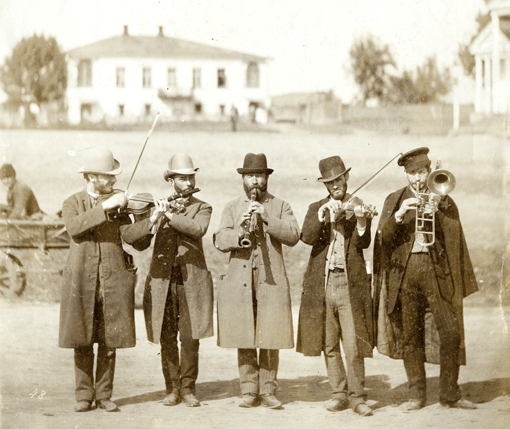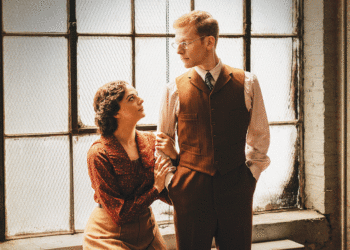Exhibit of early photographs from Russia depict Jewish life — both in the shtetl and in the urban sophistication of Vilna
By DORIS RUBENSTEIN
The vast majority of you reading this article today, like me, had grandparents or great-grandparents who came to America during the Great Migration from Eastern Europe between 1880 and 1920. The vast majority of them came from what was designated “the Pale of Settlement,” a swath of the western part of Catherine the Great’s Russian Empire, established in the late 18th century.
Our ancestors were from there, but they were not of there; always segregated, always victims of discrimination, they were seen as “the other” even when they were the majority in a town.
Just before the Great Migration, an amazing technological advance was made in communication: photography. Most Americans are familiar with early photography, thanks to the photojournalism of Matthew Brady during the Civil War. Those black-and-white stills captured with raw emotion the truth of the people and the battles that forged our country today.
Perhaps inspired by Brady’s work — or perhaps not — a group of Jewish photographers at the end of the 19th and very early 20th centuries broke away from the shtetl enough to step back and take photographic images, capturing both the physical settings where Jews lived in the Pale and the emotions resulting from the conditions of those who lived there by choice or by necessity.
The work of these photographers is currently on display in an exhibit titled Jewish Life in the Russian Empire: Photographs from the Museum of Ethnography, St. Petersburg, Russia, which is on display at The Museum of Russian Art (TMORA) in South Minneapolis.

It may be hard, especially for younger Americans who visually chronicle the most common or inane images on Flickr or Instagram, to think that having your portrait taken on a glass plate could possibly be a life-changing experience. But when the first of these photographs were displayed at the Moscow Ethnographic Exhibition of 1867, the art of photography was as new as today’s electronic imaging.
The technology was so new that the photographer was not necessarily seeking to create “art” with his work; like Brady, he was chronicling and describing an ethnic group — in this case, the Jews — for science and history.
Photography was a new technology and ethnography a new field of science in 1867. The Russian Empire at this time was vast, the largest in the world; the Pale of Settlement was only a small part of it, but it was densely populated and highly diverse. The photographers were still trying to figure out how to use the camera to tell a story, and so these earliest pictures largely show men and women in studio settings, wearing clothing typical of their shtetl occupations — a money changer; a man in prayer, draped in his tallis; a fishmonger; a melamed with children.
But they also show the sophistication of the urban Jews of Vilna. The economic strength of this merchant class of Jews is evident in the stylish suits of the men and the uncovered hair of the women.
These earliest photographs form artistic and technical foundations for the ethnographic photos of those who followed them: Mikhail Griem, Semion Ansky (a.k.a. Shloyme Rappaport) and Samuel Dudin. The Jewish subjects of their photos are unposed and captured in their natural surroundings.
In view of the misery of shtetl-dwellers in Lithuania, Belarus, Moldova, the Ukraine and Poland (not to mention the unphotographed pogroms), it’s small wonder that our ancestors fled to America, whether or not the streets were actually paved with gold — ramshackle wooden buildings on muddy, rutted roads serve as the backdrop for whole families dressed in little more than rags. Shoeless boys don’t recognize their poverty as they sit enrapt with their melamed, sharing books to learn the aleph-bet and Torah.
Earning a living was hard. We see what it took to stay alive: Jewish men are shown as tailors and bending their backs to haul logs to make matches; women are plucking fowl for feather pillows, or spinning thread to weave cloth.
The misery of the shtetl was not universal for Jews of the Russian Empire. The Vilna Jewish merchant class had its counterpart outside the Pale as seen in the pictures from Samarkand in Central Asia. One photo, titled “Young Jew Dressed in Silk Kaftan and a Hat Trimmed in Sable Fur,” tells much of the story of that community.
While condemning the czars for their anti-Semitism, we must still thank them for their vision in establishing the Museum of Ethnography and maintaining these amazing photographs that fix our ancestors’ lives in time and space for our study and enjoyment.
The project ended with World War I and then the end of the monarchy. Anyone interested in their genealogy, be your family from Berdichev, Vilna, Samarkand or Mogilev (or any of their interchangeable sister-shtetls) will be fascinated by this exhibition. While it will be on display through Oct. 20, don’t procrastinate in seeing it. And take your grandchildren.
***
Jewish Life in the Russian Empire: Photographs from the Museum of Ethnography, St. Petersburg, Russia is on display through Oct. 20 at The Museum of Russian Art, 5500 Stevens Ave. S., Minneapolis.
For information, call 612-821-9045 or visit: tmora.org.
(American Jewish World, 5.10.13)



















